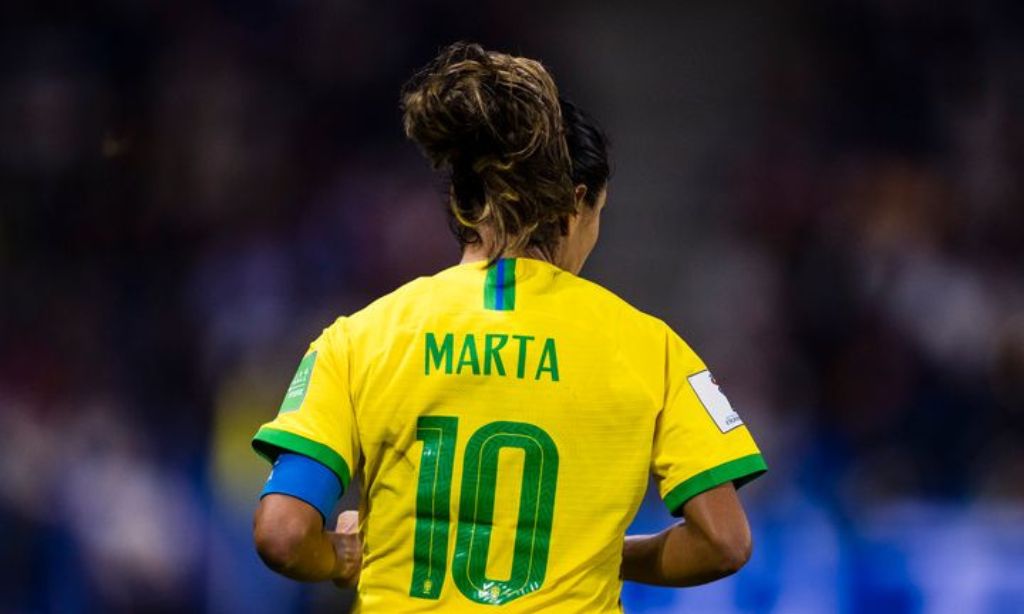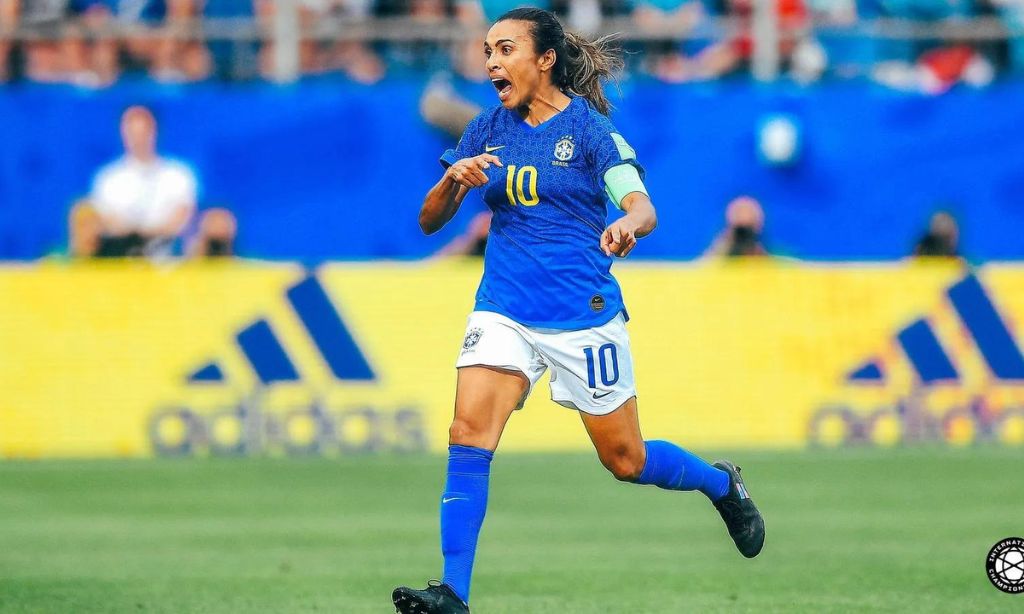Over the course of her 13-year career, the former Brazil international participated in countless of training sessions, but one in particular stands out.
Vasco da Gama’s Under-15 squad was invited up to participate in a training match against the team’s seniors back in 2000, when Sissi was a player for the Rio de Janeiro-based side.
One of them was a young woman named Marta Viera da Silva, to whom no one paid any attention at first – until they had to.
It was difficult to face her at the time since I already knew she had a gift, Sissi tells CNN Sport. “The girls had to tackle her hard every time we scrimmaged in order to stop her. She was very unique.
She used to have such fantastic ball skills. She appeared to be waiting for the defender to approach so she could perform a new move and knock people to the ground when she was close to the goal.
“We laughed about it. She was extremely talented, quick, and creative, yet it was difficult. It was difficult for us.
Being a forward herself, Sissi admits she was “glad” Marta, then 15, never needed defending because defenders “always got pissed” after confronting her. She laughs once again at the thought.
Sissi was better at attacking than she was at defending, though. Sissi won the Golden Boot at the 1999 World Cup in the United States for being the tournament’s joint best scorer, and one of the all-time great World Cup goals was her spectacular, game-winning free kick against Nigeria in the quarterfinals.
Sissi’s career would be defined by that competition, and she is still adored in Brazil for her exploits while donning the national team’s iconic yellow jersey. Sissi even flourished under the pressure of wearing the No. 10 jersey made famous by the great Pelé.
When a young Marta gave Sissi and her colleagues the runaround, the Brazilian starlet was at the height of her powers. According to Sissi, it became clear very quickly—possibly even during that first training session—that the adolescent would go on to become a star for Brazil’s women’s national team.
‘You talk about Pelé, you talk about Marta’
Even if Sissi could have foretold Marta’s route to the national team, she couldn’t have predicted the small girl from that training session would go on to achieve so much.
Marta, aged 37 and competing in her sixth and final World Cup, is widely regarded as the greatest female footballer of all time by many, if not the majority.
She has won the FIFA Player of the Year award a remarkable six times (no other female player has won it more than three times), including five years in a row from 2006 to 2010, and is Brazil’s all-time leading goalscorer, male or female, with 115.

She has also won the Champions League and the Copa Libertadores, as well as the Golden Boot and Golden Ball for best player and top scorer in the 2007 World Cup. Marta became the first male or female player in history to score in five World Cups in 2019, and her 17 World Cup goals are a men’s and women’s football all-time record.
She has three Copa América Femenina titles to her name, but the only thing lacking from her impressive resume is a major global title with her beloved national team. Marta has come agonizingly close to glory three times with Brazil, losing the 2007 World Cup final to Germany and twice losing the Olympic gold medal match.
Marta has meant “everything” to As Canarinhas over her 21-year international career, according to Sissi, pushing the team to new heights and becoming a reference point for people around the country.
“She’s an icon,” adds Sissi. “She has been a mentor to many children.”
“In my generation, there were no female players to look up to, so having players like her, especially with what she accomplished and who she became, is very important.” You’ve seen how much the game has evolved in Brazil. People can now say, ‘I want to be like Marta.’
“We have to enjoy her as much as we can… because I doubt there will be another Marta.” She’s already had a significant impact, not just in Brazil, but I believe globally. Everyone knows who she is, so I am quite happy to be a Brazilian. “I am extremely proud.”
The ‘full’ performer
During the early to mid-2000s, when Marta was emerging as a legitimate star in the women’s game, Brazil’s men’s national team was brimming with world-class players: Ronaldo, Ronaldinho, Rivaldo, Cafu, Roberto Carlos, and Dida were just a few of the world-class stars who hoisted the World Cup in 2002.
Marta clearly matched the type of the stereotypical Brazilian player of the time: a silk touch, a slick passer, and near-perfect technical ability. She is as capable of setting up goals as she is of scoring them, making her a true all-around player with minimal flaws.
Though Marta has scored numerous memorable goals during her illustrious career, the one that perhaps best encapsulates her game came during Brazil’s 4-0 rout of a United States Women’s National Team that was unbeaten in 51 games – nearly three years – heading into the 2007 World Cup semifinals.
Marta took one touch with her right foot to control a bouncing pass approximately five yards from the 18-yard box, before swiftly flicking it past defender Tina Ellerston with her left.
She sprinted into the penalty area while Ellerston furiously tried – and failed – to grab her shirt, retrieved the ball, and cut inside another defender, nearly knocking her to the ground. Marta then hammered a low effort past the goalie, who got a touch to the ball but not enough to prevent it from nestling in the net.
The combination of instinctive creativity, balance, control, and ruthlessness in front of goal was a sight to behold, and perfect mastery of ball and body is uncommon in soccer.
Marta’s game was unequaled in Brazilian soccer, according to Juca Kfouri, one of the country’s most accomplished pundits, even in a period when the country was unusually gifted with some of the finest men’s players in its history.
“Despite having players like Ronaldo O Fenômeno and Ronaldinho Gacho, there was a time in Brazil in the first decade of the twenty-first century when Marta was the person born in Brazil who had the best control of all the basics of the game,” Kfouri told CNN Sport.
“Everything: passing, shooting, heading, game vision, shooting left and right [footed].” She was a more complete football player than geniuses such as the two Ronaldos or Rivaldo, both of whom were ranked the best players in the world at the time.
“It’s difficult for us to compare Pelé to any other football player, regardless of gender, but I believe Marta’s comparison with the Ronaldos, with Rivaldo, fits in this aspect.” If you look at Marta’s grasp of the game’s foundations, she was closer to perfection than those players.”
Even the great Pelé, however, relished the comparisons, dubbed Marta “Pelé in skirts.”
Changing the game

Marta’s influence, however, has not been restricted to the field; in fact, she has used her on-field accomplishments to help establish better circumstances for female soccer players across the country.
From 1941 to 1979, it was illegal for women to play soccer in Brazil, a law Sissi disregarded as a child in order to play with the boys in her hometown’s streets. Marta was emerging as one of the world’s brightest possibilities at a time when the women’s game in Brazil was still in its infancy after years of neglect.
Marta’s reputation as the best player in the world for much of her career has compelled the country’s authorities to take women’s soccer more seriously, spending time and resources in both the national team and the domestic league.
Sissi credits Marta’s “strength to speak up” for women’s soccer in Brazil having the structure it does today.
“That’s still something she’s fighting for,” Sissi explains.
Martamania may have peaked in Brazil during the 2016 Olympic Games in Rio de Janeiro. While the men’s national team, led by Neymar, faltered at the tournament, the women’s team, led by Marta, got off to a flying start.
Despite the fact that both players wear Brazil’s renowned No. 10, fans quickly learned that only Neymar’s shirt was widely available across the country. This prompted a slew of supporters to take matters into their own hands, crossing out Neymar’s name and writing ‘Marta’ in pen on the backs of the shirts.
Even as recently as this year, a project in Marta’s home state of Alagoas was cleared to rename the ‘King Pele Stadium’ to ‘Queen Marta Stadium,’ though the change has yet to be sanctioned.
Marta gave an impassioned message to the cameras after Brazil was eliminated from the 2019 World Cup, wearing deep crimson lipstick to emphasize her preparedness to “leave blood on the pitch.”
She urged with young Brazilian females to take up the role, stating there would not be “a Marta forever.”
“Women’s football depends on you to survive.” Consider it, and value it more. “Cry at first, smile at the end,” she remarked.
Marta has carried the “fragility of women’s football in Brazil” on her back virtually single-handedly throughout her career, according to Kfouri.
“Marta is something phenomenal,” adds Kfouri. “Because you think of someone who was voted the best player in the world six times in a country where women’s football was never supported and, in fact, it was forbidden for many years for women to play football.” It’s mind-boggling that there was a Marta in Brazil.
“She was critical to the existence of a Brazilian soccer team, as well as its eventual recognition.” Women’s football in Brazil would most likely still be in its infancy if it weren’t for Marta.
“She was and is, without a doubt, a very valuable figure, both as an athlete and as a citizen.”
